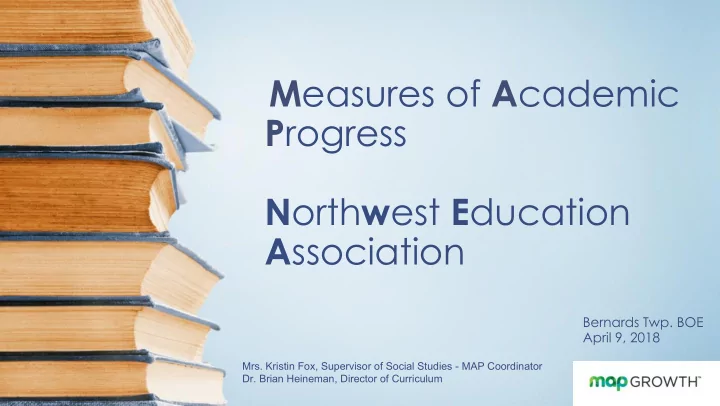

M easures of A cademic P rogress N orth w est E ducation A ssociation Bernards Twp. BOE April 9, 2018 Mrs. Kristin Fox, Supervisor of Social Studies - MAP Coordinator Dr. Brian Heineman, Director of Curriculum
Assessment • Improves teaching & learning • Results can be used to make adjustments to instructional plan; respond to student needs • 3 Types: Diagnostic (before), Formative (during), Summative (after) • MAP is a diagnostic tool while PARCC is a summative assessment • “Assessment is Messy”, no assessment tells the whole story
Why Use MAP? ● To improve student learning and provide teachers with skill-specific data measuring student growth ● To build familiarity with computer-based assessments - PARCC ● To evaluate our program and support curriculum revision ● To inform course placement decisions where appropriate
What is MAP? ● Computer-based Assessment that is: – Adaptive – Untimed – Diagnostic – Measure of typical growth – Measure of growth over time – Provides immediate feedback
What does MAP assess? • Grades 2-8 Common Core ELA Measures: – Literature – Informational Text – Foundations/Vocabulary – (Lexiles, Reading Levels) • Grades 2-8 Common Core Mathematics Measures: – Algebraic Thinking – Numbers & Operations – Fractions – Measurement & Data – Geometry
Assessment Timeline • Winter and spring administration • Tested in computer labs or on Chromebooks • Untimed • 50 minutes per assessment, on average • Teachers access student data within 48 hours
What it measures More information available at: https://community.nwea.org/docs/DOC-2568
How it works?
MAP is NOT ● An Intelligence (IQ) Test ● A Summative (Achievement) Test ❖ It does not tell us what students know, it tells us what students are ready to learn
How is MAP used? • By teachers: – To select differentiated reading materials – To create flexible groups where appropriate – To develop tiered activities • By administrators: – To analyze data for trends in student growth by grade and subject – To plan for professional development based on data
Reporting ● Results: ❖ are broken down by sub-skills ❖ are cumulative to show growth over time ❖ show student progress ❖ show district averages ❖ show national norms ❖ show comparisons to “like” districts
Class Report
Class Breakdown: Instructional Resources
Class Breakdown: Learning Continuum
Individual Student Progress Report Sent home at end of school year
Student Profile: Next Gen Report
Achievement Status & Growth Report
Achievement Status & Growth Report (continued)
Professional Development • Grade Level Meetings(Elementary) • Team Meetings (WAMS) • Professional Learning Community (PLC) Meetings • Faculty Meetings • Staff College classes • NWEA Regional Workshops
Benefits of the MAP Assessment – Focus on student growth ❖ Individualized, adaptive assessment ❖ Norm-referenced, no ceiling ❖ Provides teachers with timely feedback on student strengths and weaknesses ❖ Leading actionable data, predictive – Provides us with consistent, reliable and longitudinal data – Builds student familiarity with computer-based assessments – Additional data point for use in placement decisions; G&T, Instructional Support, Grade 7 Algebra
Research • National Education Research • NWEA: Northwest Evaluation Association – Vanderbilt, Brown, Fordham – Founded 1970s by • State Standards education researchers – https://www.nwea.org/content/uploads/2017/07/ – Non-profit organization PARCC-MAP-Linking-Study_2016.pdf – www.nwea.org • Sample pool includes anonymous data from over 10.2 million students • Growth Research Database to create national norms, pulled – 12 years, 4.5 billion test items, from more than six million test events and 23,000 schools 50 states, 7800+ partners, 8 million students • 248 schools and districts in New Jersey
Recommend
More recommend